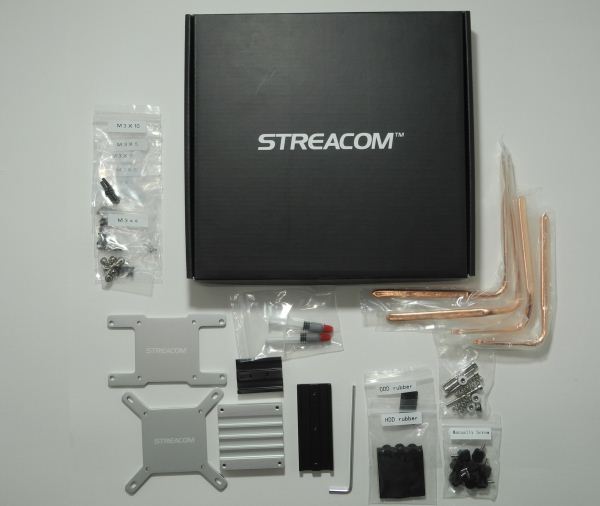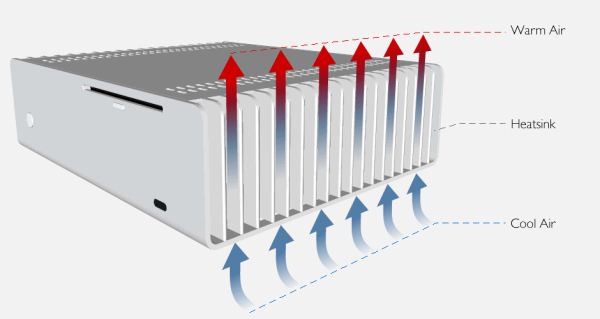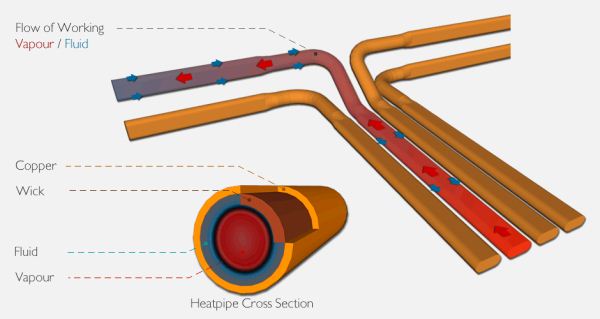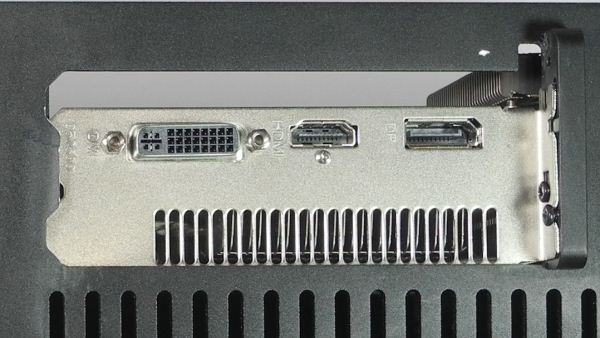Streacom's FC10 and Nano150: Building a Fanless Ivy Bridge HTPC
by Ganesh T S on December 22, 2012 3:30 AM EST- Posted in
- HTPC
- Fanless
- Ivy Bridge
Passive Build Chassis & PSU
Streacom FC10 Premium HTPC ATX Chassis:
The FC10 comes in a plain, but, easy to carry around package. The sophisticated appearance of the package belies the fact that it just contains a computer case. The internals of the package are neatly laid out, with the heat conduction plates, pipes and other miscellaneous components in one box and a detailed assembly manual on top of it.
Describing the chassis itself as a thing of beauty would be an understatement. Our sample unit came in black (silver is also available). The chassis is made of solid aluminium and has a sandblasted finish lending it a premium look. After taking a look at the case, I can say that Streacom isn't exaggerating when they claim that the FC10 is a 'work of art combining form and function'.
The hard drive bays support up to 2 x 3.5" and 3 x 2.5" drives. There is also a slim slot loading optical drive slot. There are two USB ports on the side. We also have the option to add an IR receiver to the system. The unit also has a slot to place one of the Streacom PSUs which come in 150, 180 and 250W varieties. The chassis measures 435 x 319 x 100mm and weighs 5.4 Kgs.
The FC10 chassis cooling solution support both AMD and Intel CPUs.
The cooling solution consists of two components, the fins on the chassis and the heat pipes to take the heat away from the processor surface.
The chassis fins contribute to the cooling through convection by natural airflow. The heat pipes contribute through cooling by phase change, i.e, liquid water in the heat pipes close to the processor evaporates and moves towards the chassis fins where it condenses and gets transported back closer to the processor.
Inside the chassis, we have plenty of space and even two PCIe slots. The PCIe cards have to be mounted with flexible risers. Unfortunately, here is where we encountered our first issue with the FC10. Streacom went in for non-standard spacing between the two PCIe slots. This rules out the usage of dual-slot cards in the system. Streacom came back to us with the reasoning that having the 2 slots at the normal width would have left the dividing strip too thin and weak because of the all-aluminium chassis.
Dual Slot GPU Compatibility
One of our reasons for going with the FC10 fanless chassis was to use it as a HTPC GPU testbed too. I have long since held the view that any HTPC GPU worth its salt had to come in a passive version from at least one AIB vendor. In 2012, we are at a stage where the integrated GPUs in Trinity and Ivy Bridge are more than enough for average HTPC users.
In order for users to get any meaningful HTPC capability not provided by Trinity and Ivy Bridge, a moderately powerful GPU such as the AMD 7750 or the NVIDIA GT 640 is needed. Unfortunately, their passive versions come in dual slot varieties. Not ones to be deterred by the original chassis design, we set out to fix this 'issue' (even though it is a non-issue for the majority of the builders out there). With the help of a rotary tool, it was trivial to take out the offending metal strip and polish and buff the edges. We had a little bit of trouble aligning the second fin inside the chassis, but carefully screwing in the metal plate ensured that the GPU was mounted in a stable manner.
We will be looking at this configuration in detail in the third part of the series, but it should suffice to mention here that the arrangement worked fine in operation throughout. Another minor issue is the range of PSU ratings available. Users going in for a ATX board are not going to be happy with the maximum available 250 W PSU. Streacom indicated that ATX compatibility was mentioned only because the size of the chassis allowed it. However, they expect end-users to use either mITX or uATX motherboards only.
Nano150 Fanless PSU
The Nano150 fanless PSU consists of two major components, the power brick AC / DC adapter and the power delivery module which slots inside the chassis. The power brick output is rated for 12.5A at 12V and operates in the 100 - 240V / 50 - 60Hz range. The bundled power plug was of the EU variety. It isn't much of an issue as the power plug is detachable. In any case, travel adapters are quite cheap. An alternate power cable is probably the better way to go about it if you are not in the EU. In any case, local resellers are bound to include the correct power plug.
The power brick hooks up to the power delivery module through a hole in the chassis. The module plugs directly into the 24-pin ATX power connected on the motherboard. The add-on cable set plugging into the module includes a 4-pin power connector, a molex connector and two SATA power connectors.




























63 Comments
View All Comments
colonelciller - Sunday, December 23, 2012 - link
Does the i3-3225 support 23.976 playback?Aikouka - Sunday, December 23, 2012 - link
Last I recall, Intel's drivers do have a "24 FPS" setting, but it is not true 23.976. However, my information may be out of date!casteve - Saturday, December 22, 2012 - link
Thanks for the review, but what are the units of time in the graphs? seconds, minutes, mayan long count?ganeshts - Saturday, December 22, 2012 - link
Apologize for the oversight. The time unit is in (s). The first graph is not very clear (I had actually let our power logger script run for 100 minutes = 6000s). For the loading temperature graphs, I had indicated in the text that the burn-in testing was run for 12 hours (=43200s).kyuu - Saturday, December 22, 2012 - link
First paragraph on page 3:"There was a toss up between building a Trinity-based testbed and a Ivy Bridge-based testbed. In the end, the fact that Trinity emerged as being a capable madVR candidate (with software based decoding), and the fact that madVR recently introduced DXVA scaling (an upside for Intel since its offerings weren't fully madVR capable earlier, and something that we wanted to test out) persuaded us to go for an Intel-based testbed."
Am I missing something or is this messed up? You describe (what I assume are) positive aspects of Trinity, then use that as the justification for using Ivy Bridge? Huh?
ElvenLemming - Saturday, December 22, 2012 - link
The way I interpreted that was that because the madVR support is newer and less-tested for Intel, they decided to go with an Intel build here so they could use the same machine for future madVR testing.The paragraph wasn't worded very clearly, but that's what I got out of it.
ganeshts - Saturday, December 22, 2012 - link
Yes, I could have conveyed that in a better manner, but ElvenLemming's interpretation is right. In our Trinity and Ivy Bridge reviews, we found that 720p60 H.264 streams gave trouble to HD 4000. Recently, madVR introducied DXVA scaling, and I have it from very reliable sources that Mathias (madVR developer) is working closely with Intel. So, we wanted to have the right platform to evaluate these developments.kyuu - Sunday, December 23, 2012 - link
Ah got it. Thanks for the clarification.Schafdog - Saturday, December 22, 2012 - link
What's the idle power of the system?ganeshts - Saturday, December 22, 2012 - link
That is coming in Part 2 of the review :) As a sneak peek, I can say it is around 28 W. Power measurement during Blu-ray playback and other workloads will be dealt with in detail in the next series installment.